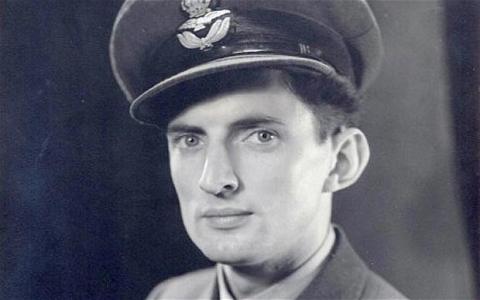Bert Smith joined the RAF in 1939, trained as a navigator, and flew bomber operations over Germany before becoming a bombing instructor in Coastal Command.
He transferred to No 575 Squadron in Transport Command in 1944, and after becoming a fully qualified pilot flew a Dakota as co-pilot to Flying Officer Ed Henry; an easy going Canadian with whom he got on very well.
They took part in the Normandy and Arnhem operations, where they towed a Horsa glider on the second lift on Monday 18 September 1944. Amongst its passengers was Lieutenant-Colonel Haddon of the 1st (Airborne) Battalion, The Border Regiment, who had been thwarted in his first attempt to reach Arnhem the previous day when a broken tow rope had forced his glider to cast-off over England.
As the formation crossed into enemy territory, the Dakota was hit by a shell burst. Ed Henry was killed immediately, Smith was bleeding from the inner side of his right arm, and everyone else aboard was carrying a wound of some description.
Smith struggled to control the badly damaged aircraft; he did not know until he landed, but much of the tail had been shot away damaging the rudders. The glider pilots in the trailing Horsa, seeing that their tug was clearly in trouble, radioed through that they were going to cast-off, but Smith told them to remain attached until he had brought them back over friendly territory. The combination of a damaged craft towing the dead weight of a Horsa made flying conditions most difficult, but Smith managed to get them across the British lines where the glider cast-off and made a safe landing.
After recovering from his wounds, Smith who was a Warrant Officer at the time was invited by the BBC to make a radio broadcast about his experience.
He was awarded a Distinguished Flying Cross for his bravery and the citation concluded: "He set a fine example of courage and resource in the face of great difficulties.”
Smith was commissioned after Arnhem and spent the rest of the war ferrying supplies to Allied Forces as they advanced into Germany.
When hostilities ended he studied to be a teacher and retired in 1963 as Senior Master at Ashfield Boy’s School in East Belfast.
Profile photograph courtesy of The Daily Telegraph.
With thanks to The Daily Telegraph and Mark Hickman (Pegasus Archive)
Read More

Latest Comments
There are currently no comments for this content.
Add Comment
In order to add comments you must be registered with ParaData.
If you are currently a ParaData member please login.
If you are not currently a ParaData member but wish to get involved please register.